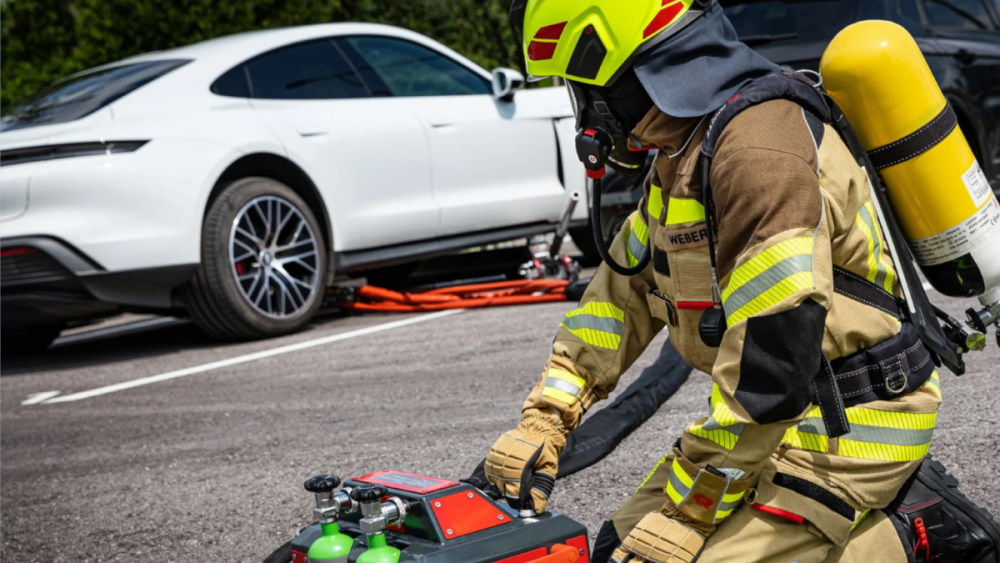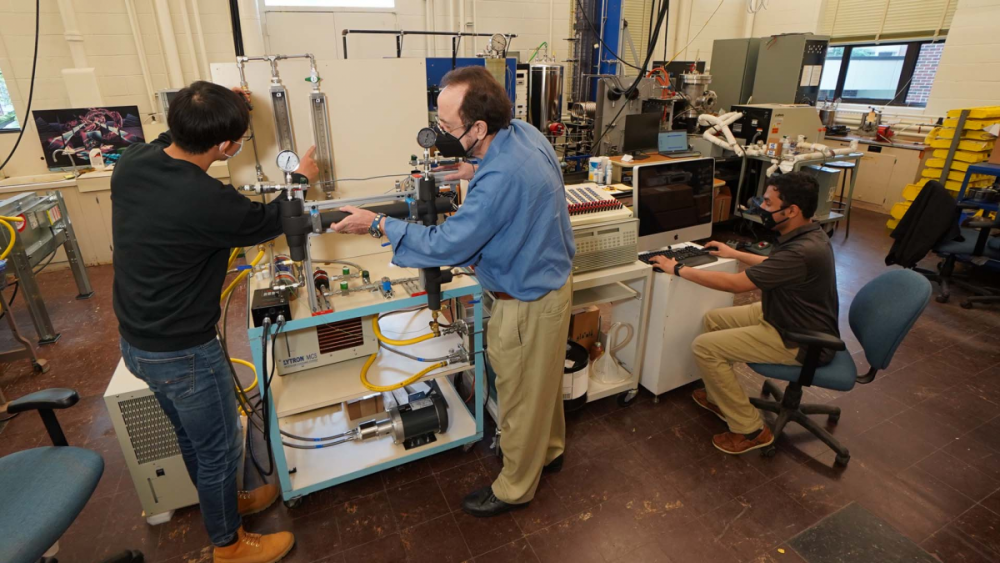Search the Community
Showing results for tags 'Innovation'.
-
https://www.thedrive.com/tech/43172/ev-fire-extinguisher-pumps-water-straight-into-the-batteries <EV Fire Extinguisher Pumps Water Straight Into the Batteries The extinguisher hopes to make fighting EV fires easier for emergency crews. Electric vehicles pose a unique risk on the road, in that their lithium-ion batteries can catch fire and burn fiercely in an accident. Fighting these fires poses a challenge for emergency responders, which Austrian firm Rosenbauer hopes to solve with its new extinguisher specially designed for the task, as reported by Rideapart. The system consists of an extinguishing unit which is placed under the target vehicle, and a control unit which can be operated by firefighters from a safe distance, with the two connected by hoses. For cars on their side or roof, the extinguisher unit can be placed on the top of a vehicle, or even in the interior or luggage compartment, in order to best access the battery. Once activated from the control unit, the extinguisher drives a piercing nozzle into the battery pack, allowing it to pump water directly where it's needed to cool the battery modules or the cells themselves. It's an effective way to bring the battery temperature down, calming the thermal runaway that makes lithium-ion battery fires so spectacular. Being able to directly fill the battery with water is a far more efficient way of fighting a battery fire than simply blasting away with a hose from the outside. Rosenbauer notes that this has multiple benefits, allowing crews to put out EV fires more quickly, while also reducing the amount of harmful smoke and gases released along the way. The system also allows firefighters to remain at a safe distance, 25 feet away from the vehicle, operating the control unit rather than having to hold a hose. The extinguishing unit can also be left attached to the vehicle during transport, once the fire has been put out. Damaged batteries can sometimes catch fire again after initially being extinguished, so having the unit still attached allows more water to be pumped into the battery if necessary at a later time. The system has been tested in partnership with several organizations to ensure the hardware is fit for service. Patrick Looß, head of the Securitas Fire and Safety department in Leipzig, Germany, noted that "The extinguishing system is currently one of the best and most innovative of its kind to contain the spread of battery fires. Operation is very user-friendly and effective. From my point of view, the system is a must-have for every fire department." Expect to see this and other similar solutions become popular with fire departments as more electric cars get on the road. Alternatively, if solid-state batteries ever go mainstream, their lower flammability could also go a long way to solving the fire issue. Until then, however, fire crews around the world will need to be prepared to deal with battery fires, and gear like this goes a long way to helping in those situations.>
- 6 replies
-
- electric vehicles
- electric cars
- (and 10 more)
-
https://www.thedrive.com/tech/43155/ford-purdue-cooling-patent-could-charge-evs-as-fast-as-gas-station-fill-ups <Ford, Purdue Cooling Patent Could Charge EVs As Fast As Gas Station Fill-Ups Heat management is crucial to faster charging, and this patent has a built-in way to keep things cool. Battery science is a pretty undeveloped field, which is why we're still using lithium-ion instead of ultra-efficient metal air or sodium chemistry. During the period when burning fuel to generate power was always the easiest option, there wasn't a motivation to make storage a priority and when it comes to EV charging, from infrastructure to materials and methods, we're in the absolute infancy of what might get done. This is why it's extremely cool to see Ford working with Purdue University on a potentially game-changing charge cable. The patent's still pending and this isn't in the production stage, so it'd be years before it could be rolled out. But Ford has shared details about the research, which has come up with a solution that could drastically cut EV charging, Ford says, maybe even down to the same amount of time it takes to fill up a gasoline car. Before I dive into how it works, let's discuss the basics. One of the things about charging a battery, as anyone who's ever plugged their phone in on a warm day will know, is that it gets hot. And as you'll also know from plugging the charger in, it's not just the battery—the cable, the adapter, everything gets real warm because of the current flowing through it, especially as you increase that voltage for faster charging. You can lower how hot parts of it get by using higher-grade, less resistant materials but not only is there a financial cost to that, it also generally means you need rarer stuff and it's not like metals and minerals we're using for technology aren't already a problem. The heating up limits charging and causes the equipment, on the battery and charger side, to degrade faster. So one key to improving charging—which is to say, making it faster—is managing that heat. Ford's partnership with Purdue has come up with something pretty interesting, which is a cable made with liquid cooling built into it. PURDUE UNIVERSITY Liquid cooling is pretty fancy, in a battery—AMG is rightly pleased with its direct-liquid-cooled energy store that's basically apeing the Mercedes F1 battery—but it doesn't need spectacularly precious elements. Building it into a cable is clever enough in the first place, given the cable needs to flex but Ford and Purdue's research has also got a stage smarter than anything else around so far. The cooling agent that the cable uses switches between being a liquid and vapor, which is a heat-reductive process. Like the reason humans sweat, when something vaporizes it takes heat from its surroundings, wicking the excess away from the charging cable wires. That also doesn't require the liquid to be pumped around in order to circulate its heat reduction capabilities. Purdue mechanical engineering professor Issam Mudawar led on the project, alongside Ford's engineers. In Ford's news release, Mudawar said that a prototype cable should be being tested within the next 24 months, in order to work on seeing how much difference the cable makes to vehicle charging times and how much it increases potential current. That's very exciting, even if it's still a long way off being a production concern, especially because this isn't Ford saying it has a new type of proprietary plug, this is actually a new way to use cooling technologies altogether. Although there was quite a lot of bombast in Ford's release about this to say it could bring EV charging times down to equivalent to refueling, that bits in the handwave phase at the moment. We don't know how much it will actually improve charging times or if the system is, for instance, robust enough to withstand thousands of charge cycles—that's the point of research, that it's still getting worked out. But it's a nifty innovation and it'll be interesting to see where it goes.>
- 21 replies
-
- 3
-

-
.png)
-
- electric vehicle
- battery
- (and 6 more)
-
Bridgestone announced it has developed a non-pneumatic concept tyre that could turn out to be a safer and more environmentally-friendly alternative to conventional tyres in the future. The innovative tyre is 100 percent recyclable and uses a thermoplastic resin spoke structure along the inner sides of the tyres that supports the weight of the vehicle. However, perhaps the most important advantage is that the non-pneumatic tyre increases the safety level as the risk of punctures potentially causing a fatal collision is eliminated. Although such concepts were presented in the form of the Michelin Tweel and Resilient Technologies' honeycomb design, Bridgestone states in a press release that previously such concept tyres have been impractical to produce for the mass market. Bridgestone developed this technology with the aim of practical implementation. Such a tyre also eliminates the need to carry a spare tyre, thus freeing up the boot space. This has a weight-saving advantage as well and contributes to better fuel efficiency. Looking at the design of the tyre, I am not sure how it can be fitted to the car with bolts and nuts. In addition, if the inner surface of the tyre is exposed like the pictures above, some stones from the road might get trapped to the spoke structure. Another question to be answered is the structural integrity of the spokes over time and its working lifespan. And finally, I believe most motorist would be concerned about its selling price, should the concept goes into production eventually.
- 1 comment
-
- new technology
- safety
- (and 7 more)
-
According to sources, the latest patent is registered under Christoph Krah, an Apple employee and inventor. He was previously been credited on some of Apple's earlier patents regarding holographic imaging. This means in future iPhone/iTV/iPad generation, there maybe an advanced 3D visualization and gesturing system. Kinda like MS's Kinect, but application used in mobile devices can read your hand gestures and voice interface without touching. Source: http://www.patentlyapple.com/patently-appl...ng-toolbar.html
-
-
ZF, the German company that is famous for manufacturing automotive transmissions has developed a nine speed automatic gearbox for front wheel drive passenger cars. Yes, NINE forward speeds and it isn't a typo. And we thought seven or eight gears was more than sufficient for most cars. ZF has also stated that this gearbox isn't a prototype as it will be making its first appearance in a US made Chrysler (which is now owned by Fiat) and the nine speeder will be manufactured at ZF's brand new factory in South Carolina, United States. We've heard Mercedes using their 7 speed G-tronic automatic and Lexus using their eight speeder but now ZF claims that the nine speed gearbox enhances driving performance and also maximizes fuel economy. This compact looking nine speeder is similar to ZF's eight speed automatic gearbox for its rear wheel drive cars in its design and its characteristics. It will select the
- 4 comments
-
- Industry news
- innovation
-
(and 1 more)
Tagged with:
-

Tight spaces require a car turntable. Anyone selling one locally?
Rigval posted a blog entry in MyAutoBlog
[extract] Those in high density urban areas know that space is premium and the price for space is sky high the closer you get to the city centre. Aside from the need for personal space at home or at the office, there is also a need for space to park one- 2 comments
-
- car turntable
- innovation
-
(and 1 more)
Tagged with:





